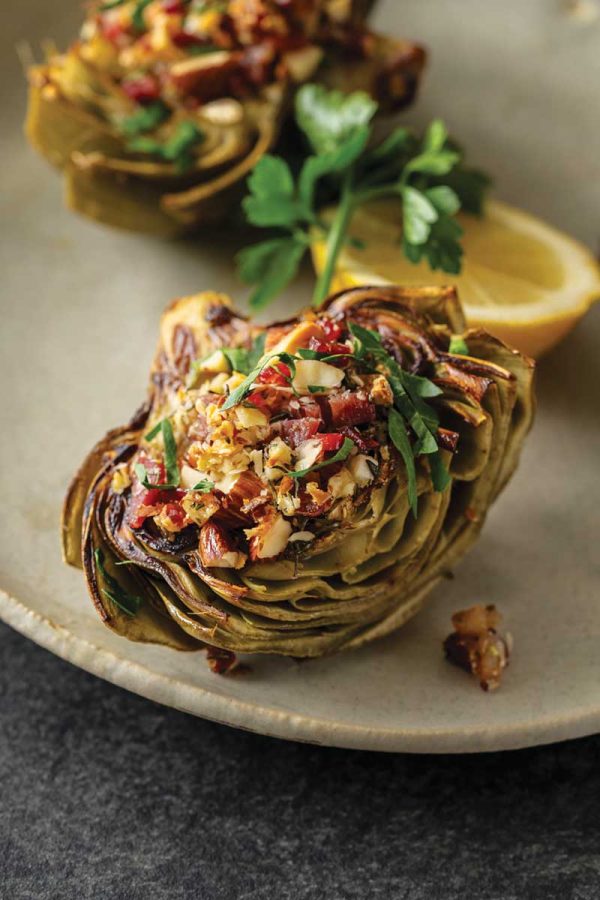Artichokes can be somewhat intimidating. But once you’ve made your way past its spiky exterior and removed the thistlelike choke, there lies a tender heart with a sweet flavor. The meaty bases of artichoke leaves are also edible and make perfect dipping vehicles to scoop up sauce or, in this case, a stuffing with just a touch of Spanish serrano ham and Marcona almonds. Artichokes take a bit of care to prepare—and to eat—but they present a wonderful opportunity to slow down and savor flavorful ingredients. Don’t be afraid to use your hands!
How to clean an artichoke
- Fill a bowl large enough to accommodate artichokes with water. Cut a lemon in half, squeeze the juice into water, and drop lemon halves into water. Cut a second lemon in half and set it aside. You’ll use this to brush the artichoke as you trim it to prevent the blackening that occurs as the artichoke is exposed to oxygen. You can also rub your hands with lemon, which will stop your hands from blackening.
- Wash and dry your artichoke.
- Remove tough leaves around the base of the stem by pulling them away from the body of the artichoke, rubbing artichoke with lemon as you do so.
- With serrated knife, cut through artichoke crosswise, about 1 inch from the top. Rub exposed part with lemon.
- With kitchen shears, remove spiky tips of remaining outer leaves. Use peeler to remove small leaves near the stem and the tough outer layer of the stem. Rub peeled stem with lemon.
- Using serrated knife once more, cut through artichoke lengthwise, severing the bulb and stem. Again, rub all exposed parts with lemon.
- Use small paring knife to cut around the spiky, hairlike choke and then use spoon to scoop it out.
- Rinse artichoke quickly under water and then place in bowl of lemon water while you prepare the remaining artichoke.
“One slice of ham, please”
Jamón serrano is a Spanish cured ham. It’s like prosciutto but cured longer and has a drier texture and a deeper red color. It’s typically enjoyed in thin slices, cut as required, from a whole ham. For this dish, ask your deli to cut a single thick slice of ham that you can later cut into small dice.

- 2 in artichokes cleaned and restingacidulated lemon water (see tip)
- 1 Tbsp finely chopped garlic
- 2 Tbsp picked thyme leaves
- 2 Tbsp Marcona almonds roughly chopped
- 1 oz serrano ham finely diced (see tip)
- 1 tsp Tbsp + 1extra-virgin olive oil divided
- 1 Tbsp finely chopped parsley
- Preheat oven to 400 F. Follow tip directions for cleaning artichokes and storing them in acidulated lemon water.
- In small bowl, combine garlic, thyme, almonds, and ham; set aside.
- Partially fill large saucepan with fresh water and bring it a boil. Reduce to a simmer and drop artichoke halves into water. You can also transfer the lemon wedges. Simmer until just tender, about 5 to 7 minutes. Drain and pat dry.
- In cast iron skillet, heat 1 Tbsp olive oil and place artichoke halves face down. Cook for 3 to 5 minutes on one side until browned. Remove artichokes to cutting board. Fill each half with ham and almond filling. Return artichokes, filled side up, to skillet and drizzle remaining 1 tsp olive oil over filling. Place skillet in preheated oven and roast for 20 minutes. Remove dish from oven, sprinkle with chopped parsley, and bring to the table.
- To eat, gently pull leaves from the body of the artichoke and pile filling on with a fork, before consuming and eating the fleshy base of the leaf by pulling it through your slightly closed teeth. Discard fibrous exteriors of the leaves. As you make your way to the center of the artichoke, you can consume the heart, which is soft and tender.
Per serving: 152 calories; 8 g protein; 10 g total fat (2 g sat. fat); 10 g total carbohydrates (1 g sugars, 5 g fiber); 394 mg sodium